Empty Theory: Intro into the Personnel Set That Can Unlock Anthony Richardson
The Indianapolis Colts have their franchise signal caller, as the team spent the 4th overall pick in the 2023 NFL Draft on Florida quarterback Anthony Richardson. Richardson, 20, is just oozing potential and can be the next elite NFL quarterback with the proper game-planning and development.
For all the excitement that comes with a new quarterback, developing Richardson will be a tall task for this offensive coaching staff. He comes into the NFL with just 13 career starts in college, finishing this past season completing just 53.0% of his passes. The biggest concern, when it comes to Richardson's accuracy, is how he operated in the short passing game a year ago.
Richardson was around league average in accuracy on passes that traveled over 10 yards through the air. Where he struggled mightily was from 0-9 yards down the field. Richardson completed just 58.0% of his passes in this range last year, while also throwing five interceptions.
Richardson's main issues underneath came down to rhythm, timing, and post-snap recognition. He was just a tick off on everything, which led to higher interception numbers and a lower completion percentage. Shane Steichen had a similar issue with Philadelphia Eagles' quarterback Jalen Hurts back in 2021, as the then-second year passer was coming off a season where he completed just 61% of his passes in the 0-9 air yard range.
So what did Shane Steichen do to get these numbers up for Jalen Hurts? He leaned on empty personnel. Empty is a personnel grouping that features a five man protection up front with five pass catchers out of the backfield and on the line. There are pros and cons to this personnel grouping, but this heavy reliance on empty did help Jalen Hurts with his pre- and post-snap reads in Philadelphia.
Hurts improved his accuracy in the 0-9 yard range each season under Shane Steichen, completing 74% of his passes in 2021 and nearly 80% of his passes last year in this range. I'm not saying that leaning into empty personnel is absolutely going to have the same impact on Richardson as it had on Hurts, but this is one route that Steichen could go to assist the young quarterback.
This is a new SIX part series for the site that will analyze empty theory and discuss how and why this personnel grouping is so beneficial for young quarterbacks. Today's article will focus primarily on the idea of empty theory and how it works, while future pieces will dive into elements of the personnel set.
For now, let's take a look at Empty Theory.
Empty Theory
Empty Theory is the idea that defenses can't disguise what they are doing when an offense is in empty personnel. This is obviously a major benefit to a young quarterback, as there is less time thinking (and guessing) prior to the snap. The quarterback can quickly see what the defense is running and develop a plan of attack.
My good friend Fran Duffy of PhiladelphiaEagles.com had this phenomenal quote about empty on a recent episode of Locked On Colts:
There are a lot of coaches that feel (empty personnel) is a really good thing for young quarterbacks. What they say with empty is that is like truth serum for a defense. It is very hard to disguise what you are doing from a coverage standpoint or from a pressure standpoint when an offense goes into empty... Right away, you are giving the quarterback information prior to the snap that can help a young quarterback.
The basis for reading a defense in empty is as follows. This diagram was made by @TheHonestNFL on Twitter, so please go give him a follow if you haven't already:
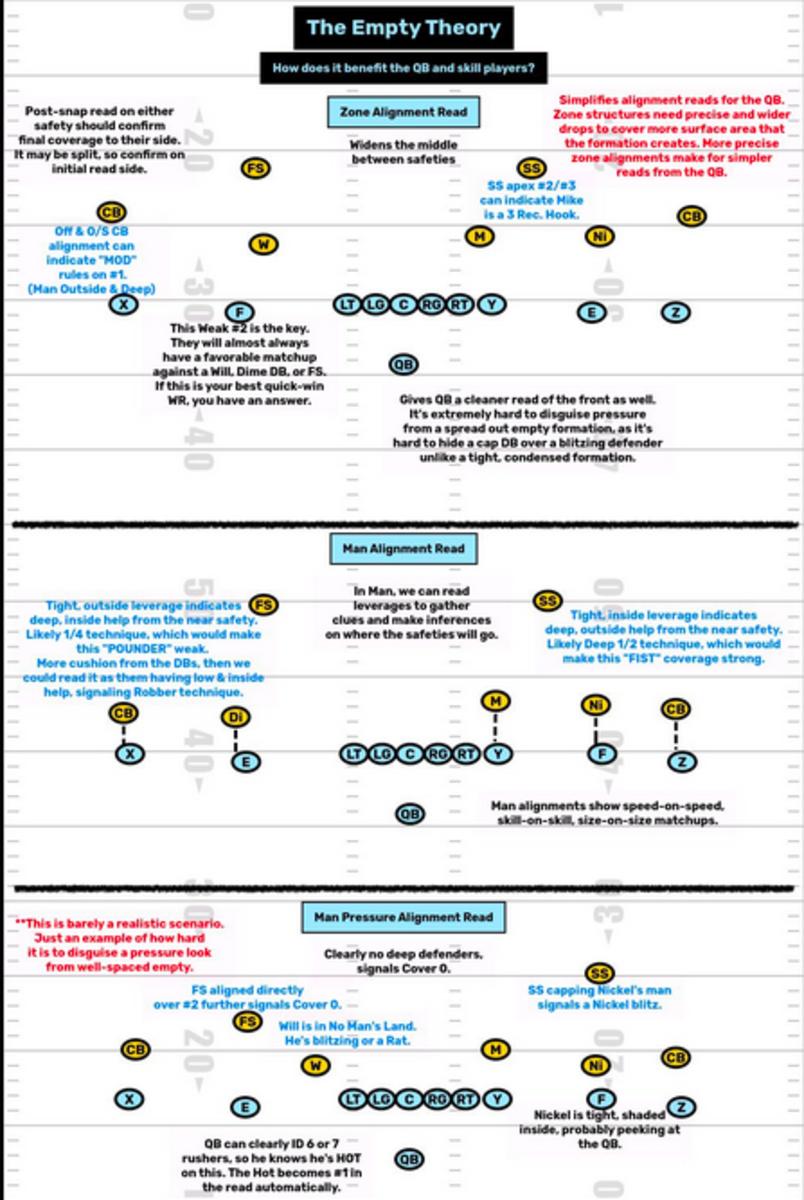
The diagram above shows, in detail, how it is easier to read defenses in empty personnel. Defenses really can't disguise what they are doing against empty due to the multiple pass threats on the outside, so quarterbacks get a fairly clean read pre-snap.
The diagram shows exactly how to read these certain coverages as well. In zone looks, the inside linebackers will typically be shading inside and covering more grass than man. In man coverages, the players will all be face up with their assignment. On potential pressure looks, the safeties will be face up over the potential blitzer on the outside (so it is easier to identify where the OL needs to adjust).
All of this to say that empty personnel makes the pre-snap reads much easier for a quarterback, which could do wonders for a fairly inexperienced player like Anthony Richardson.
Film Examples
Let's dive into some film examples from Shane Steichen's time with the Eagles in 2022. I charted 100 snaps last season where the Eagles were aligned in empty personnel, which was good for over 15% of Jalen Hurts' total dropbacks. On these calls, Hurts completed 75.5% of his passes for 842 yards and six touchdowns with just one interception last year. He also ran the ball 24 times for 241 yards and three scores out of this look.
Empty personnel was a major part of the Eagles' offense last season, and it is easy to see why on film.
This first film example has the Eagles lining up in empty against the Minnesota Vikings. The Vikings are in a match coverage call here, with the weakside defenders in man with the playside in more of a zone look.
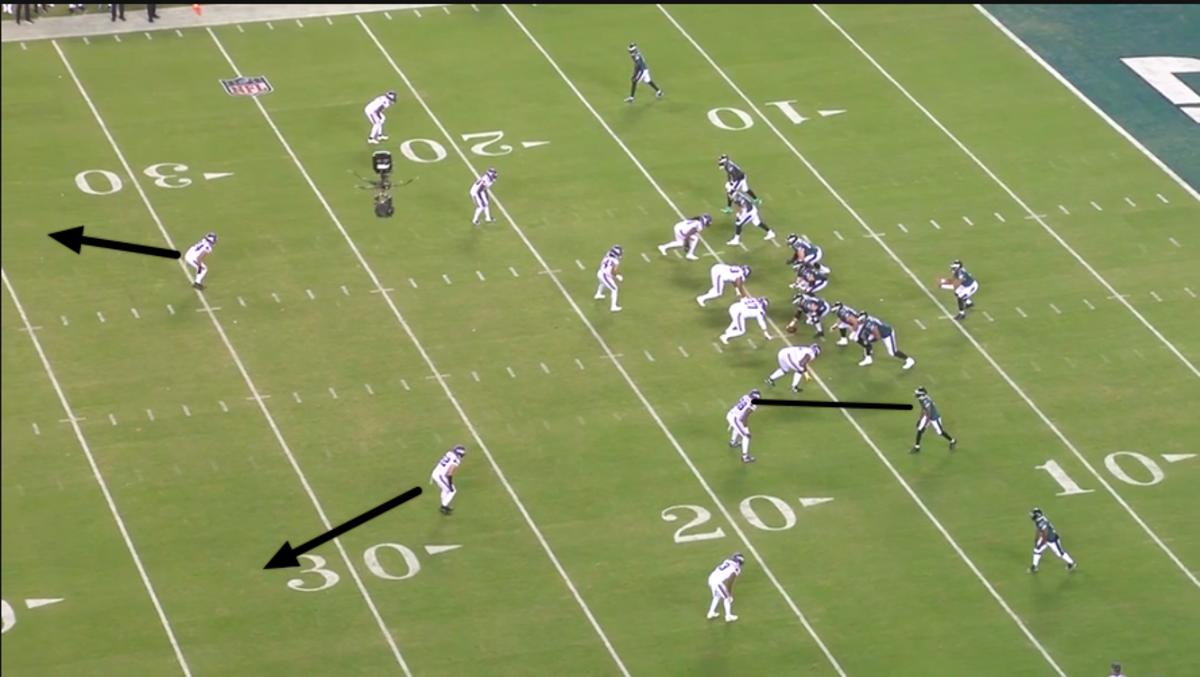
Once Jalen Hurts sees the defense in two high coverage (with the strong side linebacker shading that way), he knows the middle of the field will be wide open to exploit. Here is where the next advantage of empty personnel comes into play; match-up seeking.
DeVonta Smith is aligned as the weakside wide receiver two on the play and he is matched up with a linebacker in the slot. While this playcall does have a backside levels concept if Hurts wants to work to it, the main target is Smith against that helpless linebacker over the middle.
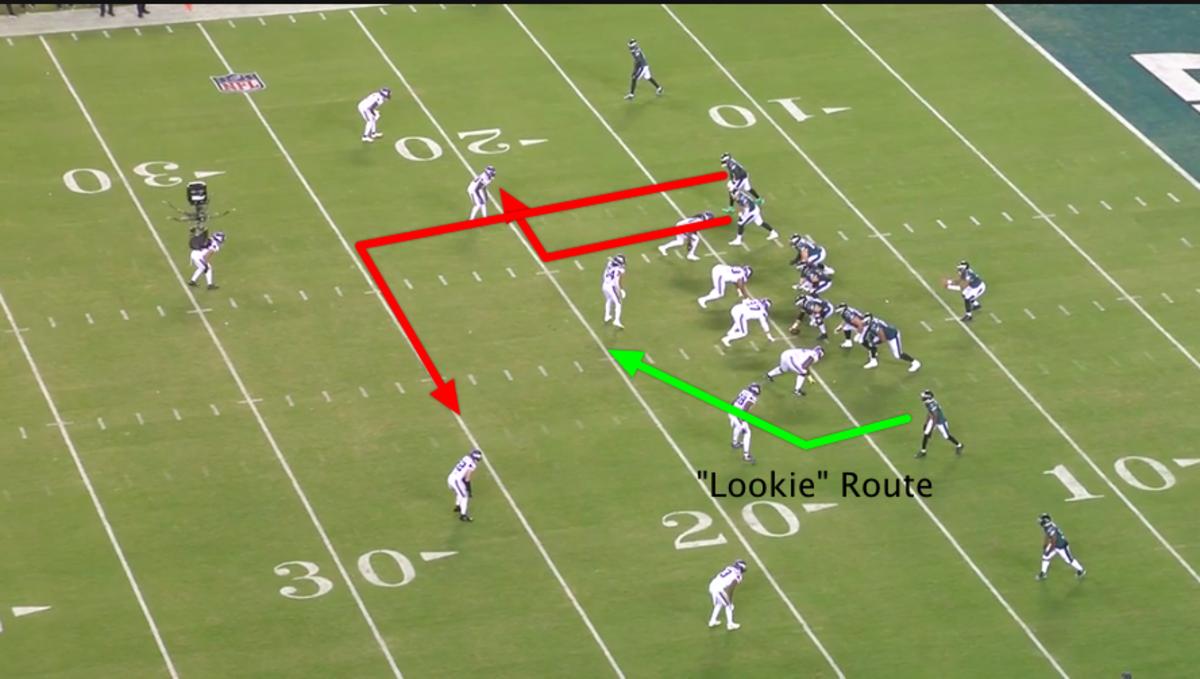
Smith is running a "lookie" route which is essentially a quick slant crossing the face of the linebacker. That linebacker simply has no chance to match the speed and quickness of a star receiver in the slot.
Smith effortlessly separates from the defender and turns a quick hitter underneath into a big gain.
— Not Zach’s Burner (@NotZachsBurner1) May 8, 2023
Now let's look at an example against zone coverage. The Eagles are facing the Chicago Bears in this example, and we know their head coach loves to roll out some cover two zone.
The Bears are showing zone from the snap with the inside backers playing heavy inside leverage and selling the zone call. Jalen Hurts is able to identify this pre-snap and match-up seek quickly before the ball is ever snapped.
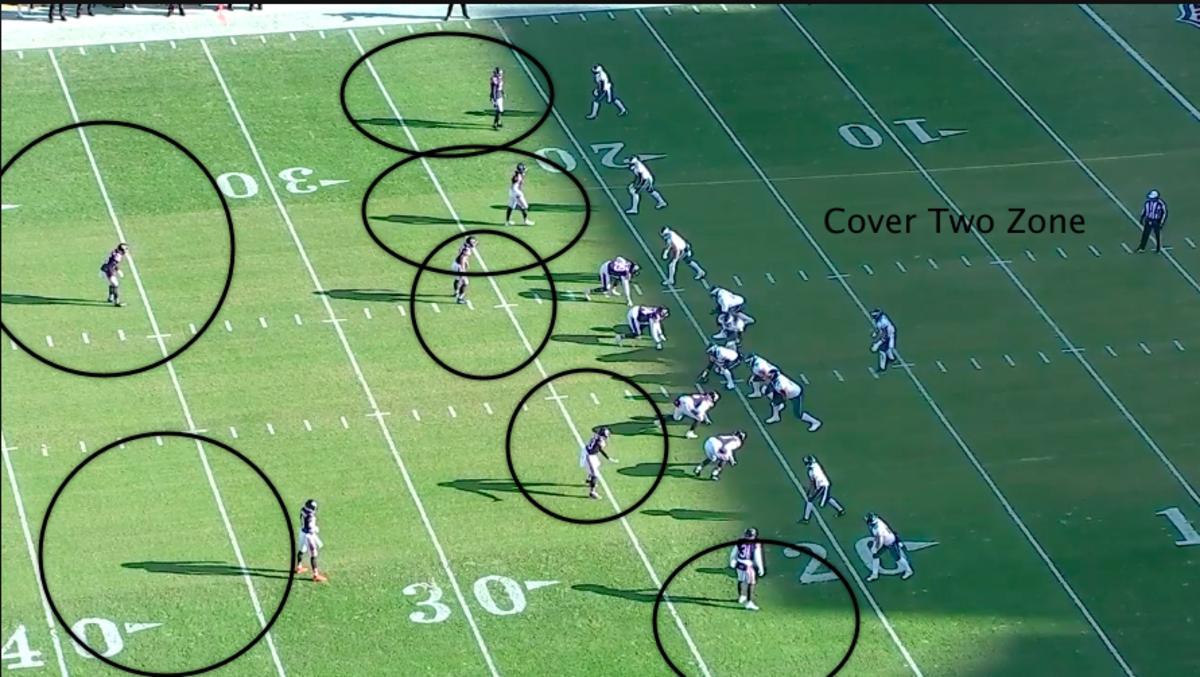
To the weakside, DeVonta Smith is back in the slot as weak two but now tight end Dallas Goedert is out wide as weak one. These two are going to work a high-low zone beater concept in the half field to give Jalen Hurts a quick outlet.
Goedert is running a spacing route and is working to the numbers and sitting low. Smith is running a dig crossing the face of the deep safety behind the squatting tight end underneath. This concept puts the zone defenders in a bind as they either have to drift back to defend the dig or crash forward to take away the spacing route.
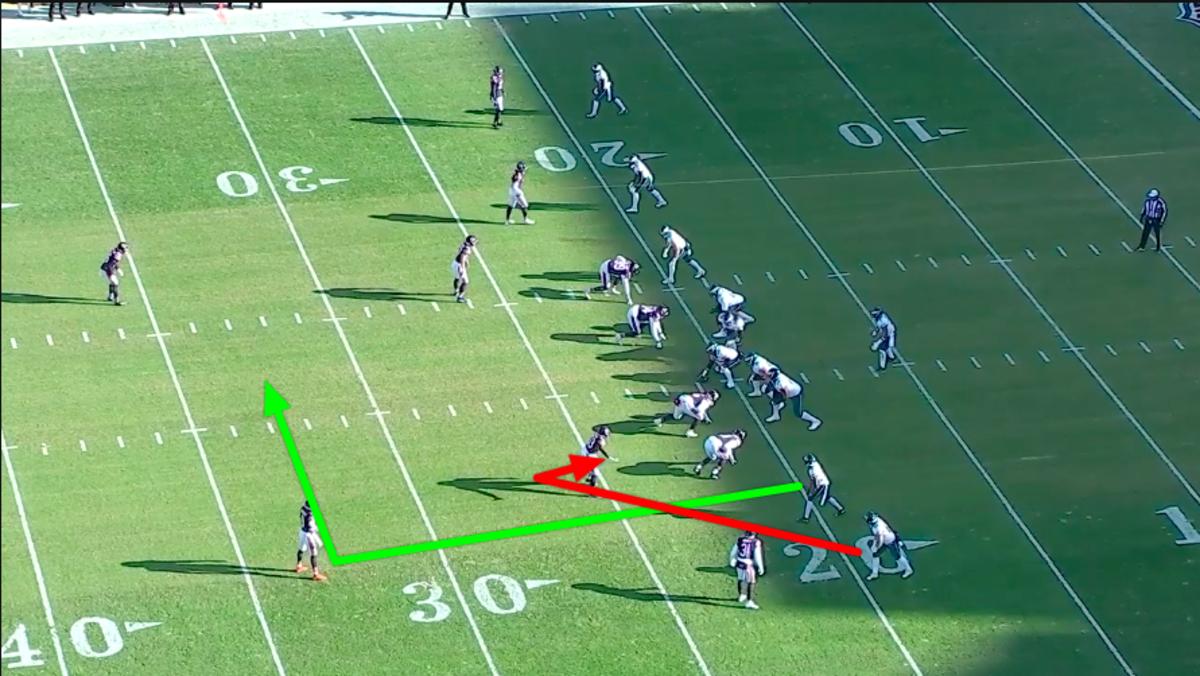
The linebacker and the outside corner stay low on the concept, leaving space behind them for Smith to uncover on the dig behind them. Smith is able to turn this catch up field and gain 45 yards on the play.
— Not Zach’s Burner (@NotZachsBurner1) May 8, 2023
These two plays show the beauty of the empty theory. A common misconception about empty sets is that a quarterback is reading the whole field with so many options in the passing game. In reality, it is the complete opposite. The entire premise of empty theory is match-up hunting.
If you have a quick-win wide receiver like a DeVonta Smith (or a Josh Downs) then empty sets allow you to isolate him, in space, against linebackers and safeties in the slot. A player with that skillset can catch 100 passes a year on quick hitters out of this personnel.
That is where the benefit comes in for the quarterback. Take Anthony Richardson for example. Instead of having him continually go through countless progressions and continually reset his feet, empty theory allows him to match-up hunt pre-snap and identify where he is going based off of one or two players. He is getting the ball out on time and in rhythm in this personnel set.
There are multiple ways to help Anthony Richardson in the quick passing game, but a heavy usage of empty personnel could go a long way in alleviating the stress off of this young player.
The Bottom Line
Overall, this is just the introductory article into what is going to be a miniseries for the site. Next, we are going to talk about that quick-win wide receiver and why it is so vital for this personnel grouping to work. For now, I leave you with this one final thought.
Shane Steichen was able to turn a young, athletic Jalen Hurts into a near MVP candidate by heavily relying on empty personnel the last two seasons. Although Anthony Richardson is a different quarterback than Jalen Hurts, it wouldn't shock me in the slightest to see Steichen pull from his own success when he begins to craft a playbook for the young athlete he has in Indy.
Need your fill on daily Colts' content? Head over to the Locked On Colts' YouTube channel where Jake Arthur and myself hit on all the major topics surrounding this team. Hit that subscribe button while you are there!
Follow Zach on Twitter @ZachHicks2.
